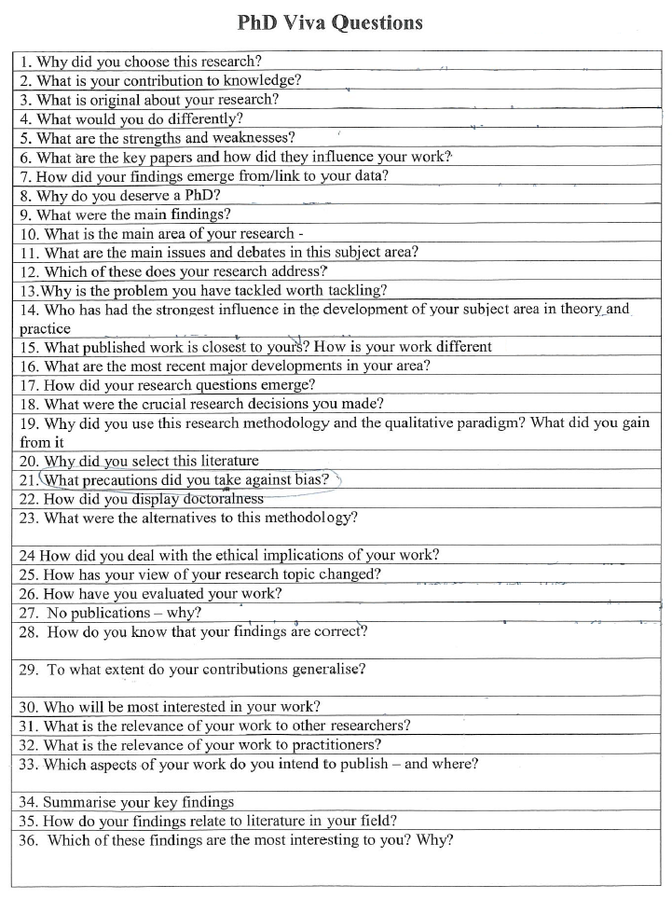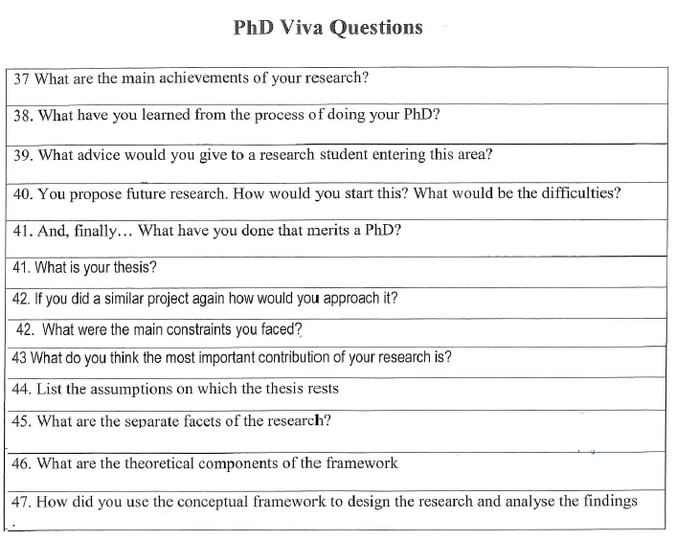Viva Requirements
1- Bring a copy of your thesis with you.
2- Come dressed in a suite to show that you are serious.
3- Stay Calm and smile.
4- Be ready for technical difficulties, such as the power point presentation and even a print out of it.
2- Come dressed in a suite to show that you are serious.
3- Stay Calm and smile.
4- Be ready for technical difficulties, such as the power point presentation and even a print out of it.
Questions to expect During the Viva
At first you have to LISTEN to the question.
1- There will be corrections.
2- Tell me about your thesis.
3- Tell me about your methodology.
4- Tell me the significance of the study.
5- Have you applied for any jobs.
6- Have you applied for any grants.
7- What was the problem and how did you solve it.
8- What did you find and what did all this mean?
2- Tell me about your thesis.
3- Tell me about your methodology.
4- Tell me the significance of the study.
5- Have you applied for any jobs.
6- Have you applied for any grants.
7- What was the problem and how did you solve it.
8- What did you find and what did all this mean?
Steps to Prepare for a Viva
1- Reading thesis carefully before the viva.
2- Think of questions the examiner will ask you, write them down on paper and answer them.
3- Know your original contribution to state that to your examiner.
4- Think of your PhD journey and all the decisions you made at the different stages you went through.
5- Think of the limitations of your project, and if you got the chance how would you do things differently.
2- Think of questions the examiner will ask you, write them down on paper and answer them.
3- Know your original contribution to state that to your examiner.
4- Think of your PhD journey and all the decisions you made at the different stages you went through.
5- Think of the limitations of your project, and if you got the chance how would you do things differently.
Whats on the Examiners mind?
1- To check that you have done the work.
2- To check that the work is novel.
3- To check that you have a broad understanding of the field.
4- To see your thought process.
5- They are treating you as the expert.
6- They want to treat you as equal to see how you will react.
2- To check that the work is novel.
3- To check that you have a broad understanding of the field.
4- To see your thought process.
5- They are treating you as the expert.
6- They want to treat you as equal to see how you will react.
How will the examiner read the thesis?
1- The examiner would read it as a story at first, to know what it is about.
2- Read the thesis to find question to ask the student during the viva.
3- To check the scince is correct and haven't missed major facts.
4- checking style and consistency.
2- Read the thesis to find question to ask the student during the viva.
3- To check the scince is correct and haven't missed major facts.
4- checking style and consistency.
How to Answer Questions During the Viva
Remember its your right to answer your question.
Ask to clarify or repeat a question if you don't get it from the first time.
If you don't understand the question from the first time try to repeat it and say did you mean..... etc.
I am not sure but I think it is .......etc.
You can say I don't know.
You can slow things down by asking them a minute just to gather your thoughts.
If you don't understand the question from the first time try to repeat it and say did you mean..... etc.
I am not sure but I think it is .......etc.
You can say I don't know.
You can slow things down by asking them a minute just to gather your thoughts.
Making a Viva Presentation
The presentation is usually from 10 to 20 minutes. Don't put to much words on the slides because the main objective is for them to keep them focused on your talked idea.
For a computational fluid dynamics viva:
1- Tell them what is the purpose of the use of the numerical model for your studied case and what would be the outcome of the generated data.
2- Show them the contribution of the work and how you compared your generated with the experiential data and what sort of accuracy was achieved.
For a computational fluid dynamics viva:
1- Tell them what is the purpose of the use of the numerical model for your studied case and what would be the outcome of the generated data.
2- Show them the contribution of the work and how you compared your generated with the experiential data and what sort of accuracy was achieved.
Unless otherwise noted, all content on this site is @Copyright by Ahmed Al Makky 2012-2018 - http://cfd2012.com

